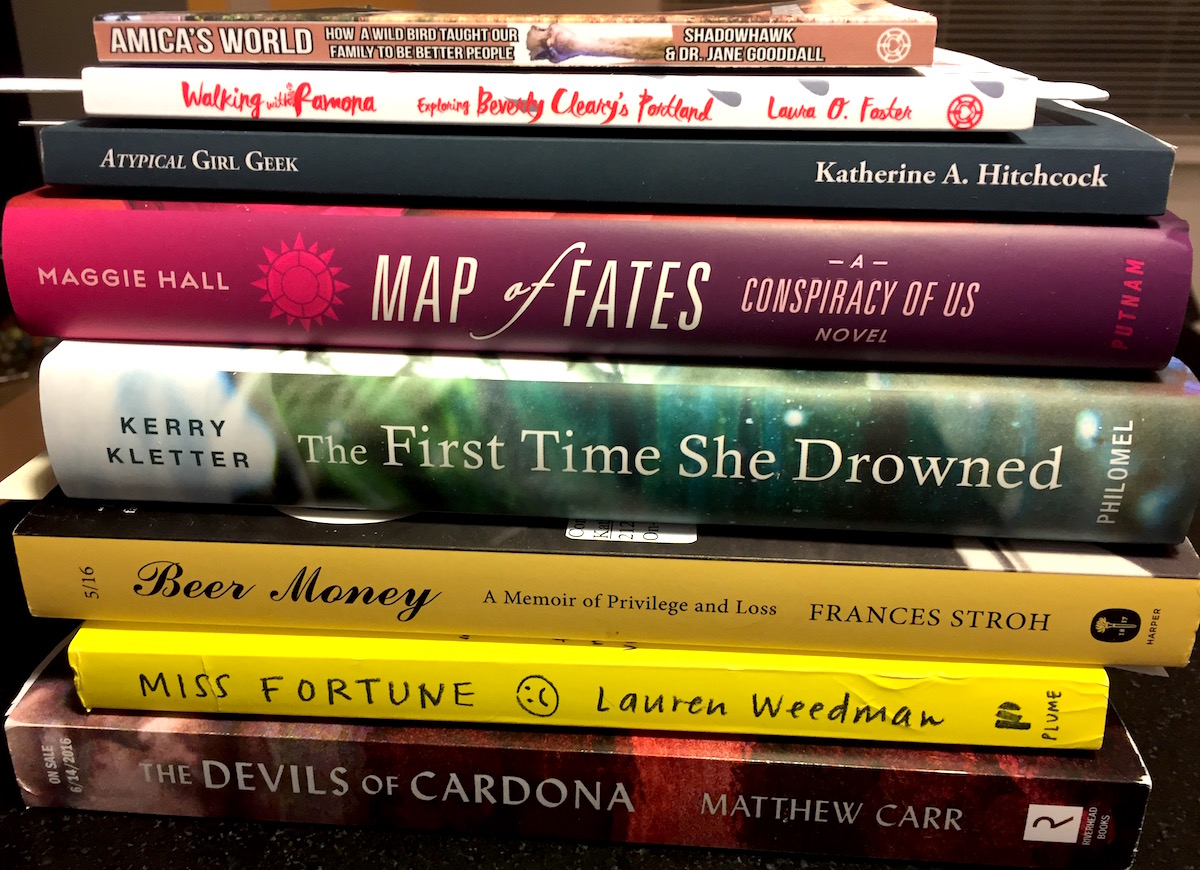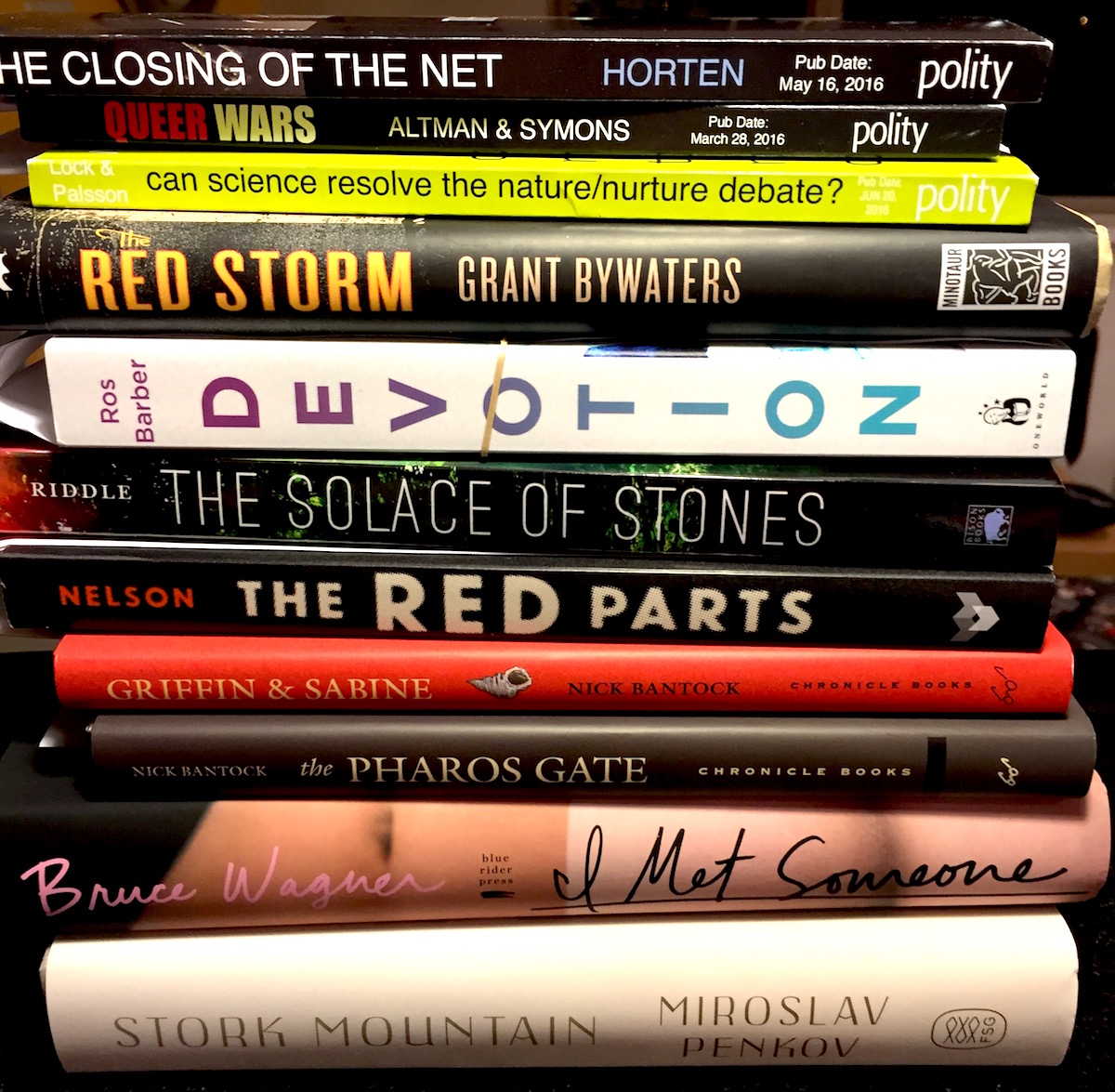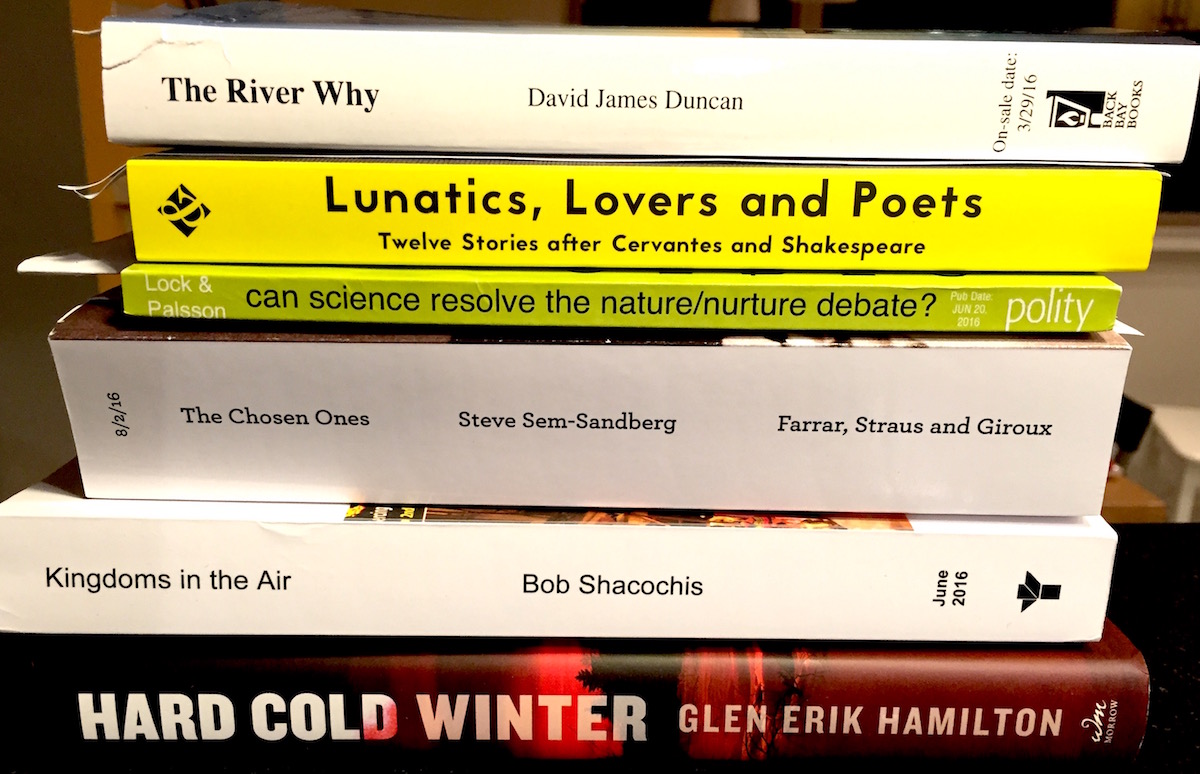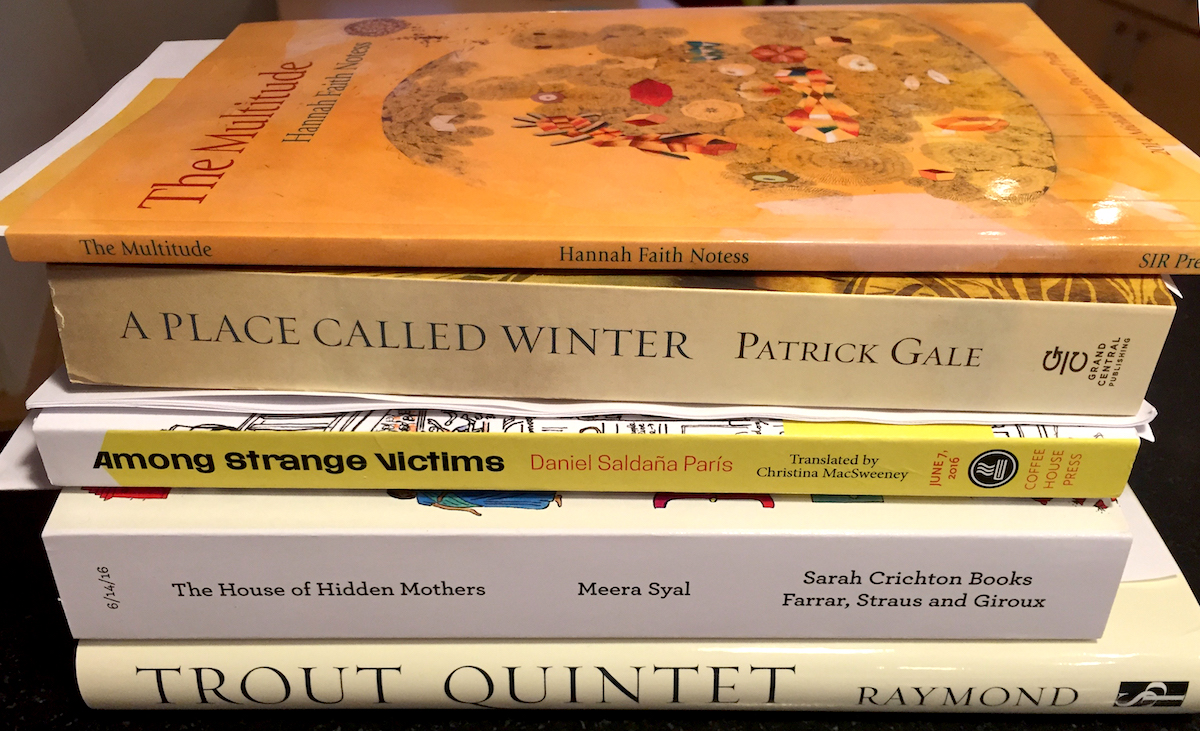Portrait Gallery: EJ Koh
Each week, Christine Marie Larsen creates a new portrait of an author for us. Have any favorites you’d love to see immortalized? Let us know.
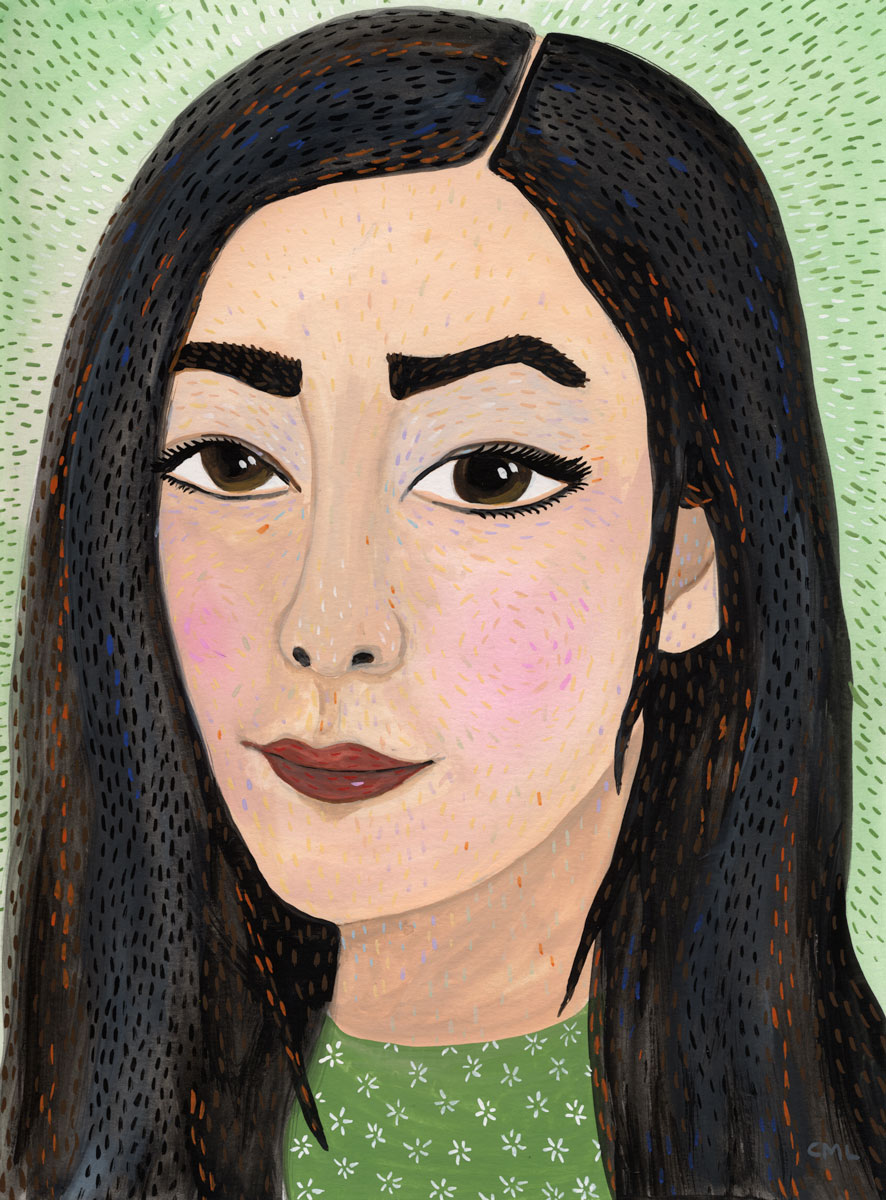
Seattle's own EJ Koh (we published her poem "Korean War") will be appearing as part of the Rainier Valley Lit Crawl this Saturday.
Lunch Date: Taking The Heart to Renton
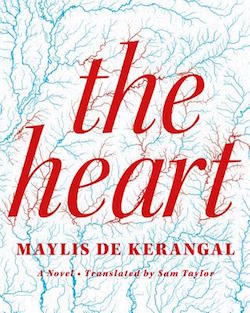
Who’s your date today? The Heart, a novel by Maylis de Kerangal and translated by Sam Taylor.
Where’d you go? I walked to Renton this weekend. I was very hungry when I got there, and I know very little about Renton, so I asked Twitter where I should go. Josh Cohen recommended Naan-N-Curry a Pakistani/Indian place that's been in downtown Renton for over a decade.
What’d you eat? I had the butter chicken ($13.99) and the garlic naan ($2.99).
How was the food? Granted, I had just walked 16 miles and so I was pretty hungry, but I thought it was really good; maybe the best butter chicken I've ever had in a restaurant. The naan could have used a little more garlic, but the chicken was thick and creamy and packed with spice. It would have been a better family-style dining experience, but as it was, I sopped up the last of the sauce with the last piece of naan, and the four-star heat was just about perfect.
What does your date say about itself? It's a contemporary French novel by an award-winning young novelist. From the publisher’s promotional copy:
Just before dawn on a Sunday morning, three teenage boys go surfing. Returning home, exhausted, the driver lets the car drift off the road into a tree. Two of the boys are wearing seat belts; one is sent through the windshield. He is declared brain-dead shortly after arriving at the hospital. His heart is still beating.
The Heart takes place over the twenty-four hours surrounding a fatal accident and a resulting heart transplant as life is taken from a young man and given to a woman close to death. In gorgeous, ruminative prose it examines the deepest feelings of everyone involved — grieving parents, hardworking doctors and nurses — as they navigate decisions of life and death. As stylistically audacious as it is emotionally explosive, Maylis de Kerangal's The Heart has mesmerized readers in France, where it has been hailed as the breakthrough work of a new literary star.
Is there a representative quote?
Pierre Révol went on duty that morning at eight. As the night sky lightened to a pale dove gray above him, far from the grandiloquent choreographies of clouds that had made the estuary's picturesque reputation, he slid his magnetic card into the reader at the entrance of the parking lot and drove slowly across the hospital grounds, snaking between buildings that connected to each other according to a complex plan, and parked his car — a gunmetal-blue Laguna, quite old but still comfortable, leather interior and good sound system: the model preferred by taxi companies, he thinks, smiling — in his reserved spot, nose first. He entere the hospital, walking quickly across the vast glass-walled lobby toward the North Hall, where he reached the Intensive Care Unit.
Will you two end up in bed together? Yes. That above passage really tells you all you need to know about The Heart: it's a novel about a heart transplant that has all the detail of finely wrought reportage. De Kerangal has clearly done her research into what goes into organ donation, and the book feels more solid and particular than most novels because of it; it only takes up a very short amount of time, but somehow the reader feels as though they understand where everyone is at any second, and why they're doing what they're doing. If it were non-fiction, it would be incredibly compelling stuff. As fiction, I could see certain readers losing patience with The Heart, but those who like to see reality reflected perfectly in fiction — those who care if a character parks nose-in, or back-in — will fall in love with this book.
Thursday Comics Hangover: The paper chase
For years, film nerds and comics nerds used to get in silly fights over which medium was better. Comics nerds would argue that you could do literally anything on a comics page, while budgets and the constraints of reality meant that movies had some natural restrictions on how far-out they could get. The dawning of CGI simultaneously imploded this argument and proved it correct; as soon as great computer special effects made it possible to put anything onscreen, superhero comics basically started dominating Hollywood’s blockbuster space.
I’ve seen a few of those message-board altercations end with the movie-nerd’s argument that a comic can never successfully portray a car chase with the same intensity and kinetic energy as a cinematic car chase sequence. It’s the kind of thing that comics nerds can’t really fight back against: one of the best aspects of comics — the fact that the reader is in complete control of the passage of time — also makes it difficult to portray breakneck action.

The trick to this, of course, is the creative team. This Black Widow is from writer Mark Waid and artist Chris Samnee, who recently wrapped up a long and refreshing run on Daredevil. In the letters page to the first issue, Waid explains that Samnee has more of a hand in the storytelling on Black Widow than he did on Daredevil; the pair have become co-plotters, with Samnee blocking the pages out on his own, and Waid adding the final dialogue to fit the art. It’s a different kind of collaboration, and it shows on the page. This doesn't feel like a Daredevil do-over; it's a whole new comic.
Samnee doesn’t get overindulgent with splash pages and easy-to-draw sequences, the way some artists do when they take up more of the creative reins. If anything, his gorgeous, simplified linework has become a little more detailed than in previous comics. The choreography of characters has become a little more involved than ever before. He’s challenging himself, and rising to the challenge. Superhero comics haven't seen this kind of a minimalist with a fluid grasp of panel-to-panel action since David Mazzucchelli moved over from Batman to art comics.
That said, a couple of sequences — involving the stealing of a jetpack and that jetpack’s explosion — could use a little more clarification. I’m not entirely sure how the cause-and-effect of those panels play out, though Samnee and Waid’s depiction of the Black Widow as an impossibly confident, competent figure certainly helps the reader make a leap. (“Of course she survived; she’s the Black Widow.”)
This issue provided several opportunities for the Black Widow to display her ability to manipulate even knowing marks into doing her bidding; hopefully future issues will examine the morality behind that skillset a little more closely. While the comic does a better job of portraying the Black Widow’s gifts for action than all her movie appearances combined, I can’t wait to see more of the superspy qualities that the movies gloss over.
This first issue of Black Widow is the kind of memorable comic that future artists will probably identify as a major influence in their work. And that’s fine; this is exactly the kind of superhero comic we want younger generations to try to emulate. Hopefully Samnee and Waid will maintain this frenetic energy throughout the series. If they build up a good long tenure on Black Widow, they’ll coincidentally prove another argument why comics are better than film — a movie has to end within a couple hours or so, while comics have the endurance to keep a character running for years.
- The delightfully named Gabrielle Bluestone at Gawker reports that nine House Republicans voted against naming a post office after the late poet Maya Angelou. Then Bluestone turns the tables on them:
“I think people should investigate Maya Angelou a little bit, and I’ll suggest perhaps if you want to investigate a little bit further that perhaps you Google ‘Maya Angelou’ and look at other articles in places like the American Thinker or the American Spectator,” Rep. Glenn Grothman (R-Wis.) said Tuesday.
Instead, we googled them.
There's still time to apply to become a Made at Hugo House Fellow. This program is sort of a writer-in-residence deal for young Seattle authors, and it provides an opportunity for writers to get together in a group and discuss the creation of new work. Plus, you get all sorts of neat bonuses like access to Hugo House classes and the opportunity to take part in group readings. You can apply through the end of this month; find a link to the form at the bottom of this page.
In other application news, you have until April 1st to apply for this year's Short Run Dash Grant, which puts $250 in cash toward the creation of a comic to be premiered at this year's Short Run. The winner of the Dash Grant will also receive mentorship, free access to a silkscreen studio, a free half-table at Short Run, and your work will be on display at Fantagraphics Gallery in Georgetown. If you'd like to read a testimonial about the Dash Grant, we interviewed the first Dash Grant winner, Krish Raghav, last year.
The writer we deserve
Published March 02, 2016, at 12:00pm
Where would you even start? William T. Vollmann's prodigious and difficult output might just make one foreswear even attempting him. But wait! Ivan Schneider has some advice for you, the nascent Vollmann reader, and it all starts with "The Dying Grass."
Meet Jeffrey Riley, the school librarian at Queen Anne Elementary
(Our March Bookstore of the Month selection is not a bookstore at all; instead, we’re going to talk to different librarians at schools around the city. If you know a school librarian you think should be spotlighted on the Seattle Review of Books, please send us an email.)
"These books are pure magic - you'll love this series!" says Serena, who just finished Magic Pony Carousel series. pic.twitter.com/zEMHMdmkJ9
— Jeffrey Riley (@QAELibrary) February 10, 2016
Jeffrey Riley is, officially, the “library media specialist” at Queen Anne Elementary, although if you ask him his title, he’ll volunteer that “I call myself a teacher-librarian because I do a lot of teaching.” In his role, he wears “more than five hats,” he says — he runs tech support for the school and facilitates reading programs for the kids — but ultimately it all boils down to two areas of expertise: the literary arts and technology.
Riley’s days are packed; he shows up to work early because he’s passionate about making sure the libarary is “open as much as possible.” Before school starts, he provides an unstructured environment for the kids “and then when the bell rings I wish them all off for a very good day of learning.” From there, he works on the collection, or helps teachers with “a new app they want to learn or a new technology they want to work on.”
After lunch is when students start visiting the library in a more structured way. This is the time that Riley seems to treasure most, when he gets to "introduce kids to a new author, or a book that just won an award, or a new literacy app."
The library, which serves kids from kindergarten through fifth grade, has roughly 12,000 titles in it, and those books are in heavy rotation. “We’re not the traditional library where first graders get [to take out] one book each, second graders get two, third graders get three, and so on,” Riley says. There’s no limit on how many books they can take home at any time, because he wants kids to “have as many books as they need.” He says most students intuitively understand the importance of bringing books back so other kids can read them.
Riley also introduces kids to the authors of the books. He’s an avid Twitterer, and he’ll often let authors on Twitter know when students like their books, and share the author’s response with the kids. He also brings authors to Queen Anne Elementary to visit, and he’ll frequently arrange Skype calls between authors and classes. (Skype is “better for our budget,” he says.) Recent visitors, real and virtual, to Queen Anne Elementary include Derek Munson, author of Enemy Pie, and Dale Basye of the Heck series. The students always have lots of questions for the authors: “what inspires you, what if you don’t want to write on that particular day, that kind of thing. They’re also interested in the relationships between the writer and the illustrator.”
So what are the kids into these days? “Kids are loving series,” Riley says. “You put an action hero or a princess or an animal in a series, it’s gonna be a winner.” Fantasy series are still huge, including the ever-popular Harry Potter books, but also the Fablehaven series and other “mystical, fantastical” books. In Queen Anne Elementary’s library alone, Riley says, “we have over 150 series.”
What else? “Graphic novels are making a big impact,” he says. Riley knows the Dewy Decimal number for comics by heart: “741.5 — that section is really growing. Your Big Nates, your Amulets, Tintin. They are flying through those comics.”
Riley likes to reward kids who read every book in a series. When they finish the last book, he says, “I’ll give them a catalog and let them order a new book” for the library. It’s a program that works to keep kids excited about reading, even if the budget doesn’t allow for its success. “I’m often hitting up parents and community members for funds so that I can reward kids with a new book,” he says. Like a lot of teachers today, Riley has a Donors Choose account, where patrons can donate funds to help keep the library in new books.
Riley has to keep dozens of reading histories in his brain at any given moment. He tracks the kids’ past experiences and always encourages them to expand into new and different reading adventures. What happens if a kid tries to take out a book that’s beyond their reading capability? “I’m not going to tell a kid not to read the book that they want to read,” Riley says. “if a kindergartner wants to read Fablehaven, I say let them have it.” But he does keep a variety of custom bookmarks onhand that he can slip into books to alert parents that “this is a book that I know is harder than your children’s level,” and so maybe the parents should read the book aloud with their children.
“I’ve got three kids on my radar, and they always want the Pokemon books,” Riley says; in fact, they refuse to read about anything but Pokemon. But rather than drop an edict or an ultimatum on the kids, he explains, “I’m going to work with the parents and figure out a plan. I might have to talk to the teacher to subtly introduce something [to the kids] to get them thinking another way. It really does take a village.”
Of course, the books do tend to get a little battered. “We have a big book drop and that’s when a lot of the fragile books get banged up.” Riley enlists the help of parent volunteers to help him repair the books. What’s his secret for book repair? “Glue, glue glue — a special book glue. And I’m constantly clear-taping.” He says with a librarian’s pride, “I have definitely proven that I can keep a paperback book going for at least three to four years.” Those extra years that he coaxes from the books with the help of glue and tape and clamps and a tireless army of volunteers result in decades of lifelong reading enjoyment for the kids of Queen Anne Elementary.
Anybody want to buy a poetry bookstore?
We just got an e-mail from John Marshall, the co-owner of Open Books in Wallingford. (If you've never been, Open Books is one of a handful of poetry bookstores in the United States. And also, shame on you for living in Seattle and never going to Open Books.) Here it is, in its entirety:
Dear Friends of Open Books,
It is with mixed feelings that I tell you I will retire from bookstore ownership sometime this year. This spring will mark the 21st anniversary of Open Books as a poetry-only bookstore, as well as mark the 29th anniversary of my owning Open Books, which started life as a small general bookstore with a large poetry selection. Christine and I have built what we could and now are running out of the initiative to maintain and improve it.
What will happen to the bookstore? We don't know. We would like to have it carry on, so we will pursue selling the store -- its stock, its name, and perhaps a reasonable lease, since Christine and I own the building. There is considerable evidence that independent bookstores are having a resurgence in this country and that the sales of actual books will not sink beneath the waves of the e-book, an unimaginably freakish future some people somehow imagined. A new owner or owners may further establish Open Books as a great place to browse for poetry books and ephemera and as a cultural hub for those interested in printed poetry in the city, the state, and around the world. Christine and I hope to shop at Open Books. We rather suspect we will have that chance. If you know of potential next owners, please share this letter with them.
This transition need not happen quickly; the decision was not based on economics or health. Open Books will remain open regular hours, we will continue to order books and hopefully you will continue shopping here. By continuing to shop here you can be a partner to the store's changing hands. We will seek new ownership for up to four months. If by the end of June new ownership does not appear possible, we will look towards other options.
My feelings are mixed. These last twenty-eight plus years have been amazing. I've learned more about poetry and people and even commerce than I could ever have thought possible. I am pleased that Open Books has been a place where aesthetic and personal eccentricities are valued -- bookstores usually are, bless them all. The store has been, and will remain inextricably, my life. I will miss much of it, but I am ready to experience the pleasure of books and reading as entirely and solely personal. I may engage in the world of poetry as commerce again, and I may not. I am excited to learn by going where I have to go.
With great affection,
John
People, listen to me. Open Books is an absolute treasure, and it's a necessary fixture in Seattle's literary scene. If you, or someone you know, is interested in carrying on the Open Books legacy, please contact them immediately.
We'll have more on this story in the weeks to come.
The making of the social network
There once was an app called called Readmill. For a brief time, it was the best literature reading and social app. You stored and read books there, like a Kindle (although, only in the open ePub format). You could highlight sections in the book, and your friends could like, or comment on the quotes. You could sum up the book at the end. It was rather like a well-designed GoodReads mashed-up with a Kindle app that cared deeply about typography.
Like many good things in the digital world, Readmill didn't last. They shut it down in March of 2014. I didn't use it all the time, but it was, to this day, the only digital reading experience that I loved. Imperfect, unfinished, and you could see cracks in the corners of their development, but my god, it was built by people who loved books, it just showed. They cared about what they were doing, and they lead with their hearts. They showed that making fine products is not a feature list, it's a execution thing.
The fellow who started CD Baby, Derek Sivers, talked about this in a blog post from 2009:
To me, ideas are worth nothing unless executed. They are just a multiplier. Execution is worth millions. Explanation:AWFUL IDEA = -1
WEAK IDEA = 1
SO-SO IDEA = 5
GOOD IDEA = 10
GREAT IDEA = 15
BRILLIANT IDEA = 20
-------- ---------
NO EXECUTION = $1
WEAK EXECUTION = $1000
SO-SO EXECUTION = $10,000
GOOD EXECUTION = $100,000
GREAT EXECUTION = $1,000,000
BRILLIANT EXECUTION = $10,000,000To make a business, you need to multiply the two.
The most brilliant idea, with no execution, is worth $20.
The most brilliant idea takes great execution to be worth $20,000,000.
That's why I don't want to hear people's ideas.
I'm not interested until I see their execution.
How much is a shared quote feature worth? How much is highlighting your favorite passages worth? How much is the ability for friends to follow you worth? How good is the idea, and how good is the execution?
Yesterday, Paul talked about this new app called Litsy. I'm on, now (username: hellbox), and we also snagged a spot for the Seattle Review of Books (username: seattlereviewof. Why not stake that early ground? If the app takes off, we want to be a part of it).
Like nearly all startups (and I work at one), I wish them success. It's really, really hard to build a good app. It's even harder to build a successful app. If you can do both…well, look at the multiplier table above, there's a reason VC's pay dearly for people who know what they're doing.
Litsy feels like a 1.0 app to me. It's clunky, its interface is awkward and unsophisticated. It's missing things that I feel should be paramount to an app like this (I can only login on the app, but that means I have to type a long password, and there's no tie-in to 1 Password or other password managers).
When you get inside, it's essentially Instagram, but where Instagram is measured, polished, and subdued, like a commercial university, Litsy is bold, like a preschool. It's as if they didn't quite trust the users to get what the icons represented, so they made them too big. Even though I have 0 books read, 0 pages red, 0 likes, 0 comments, and 0 books added, I somehow have a "litfluence" of 42. Nods to Douglas Adams aside, this is completely arbitrary. Why should I want to earn any points when I start out with so many in the first place?
If I want to post, I can Review, Blurb, or Quote. The input page is unsettled as well, with most elements much too small (it appears to me that it was largely designed in Sketch or Photoshop without having been seen on a real phone screen). The three different types of posts are further confused because apart from a bolted-on rating system (which, I liked better than Paul, especially since it had a "bailed" button: I walk away from books freely, and a little shorthand for those that want a quick report is not unreasonable) the screens were pretty much identical. Why have all this replication? Why not see what kind of content the user is posting from context? Why have the different types at all, instead of one posting type that has options if you want to pick them, like Facebook? I mean, these are well-tread patterns without a compelling reason to go another way.
Other problems abound, it's slow to load images, and on my iPhone 6, and it scrolled clunky. There's no gimmee interactions, like double-clicking on a photo to like, that they may have picked up from Instagram and other social networks to instantly familiarize and ground users. It's not a mess, exactly, but it's not polished. It needs a user experience overhaul, in my opinion, and a reconsideration of the flow through the app.
But the truth is, my opinion on this doesn't matter in the slightest.
I know nothing about the Litsy people. I suspect they're not venture backed, or if they are, then it's very early rounds to get their proof-of-concept out the door. They're not listed on Product Hunt, and their About page is thin on any info about them.
The problem all modern app social startups face is a huge one: they're not competing against other small app makers, they're competing against Facebook, Twitter, and Instagram. They're competing against some of the largest, best run companies (well, Facebook) in the world. Litsy has to convince its users to use them instead of posting on those known networks where people have known friends. Where people have built networks, and social capital.
With that in mind, investing in interface and design too early can hamper the app in two ways:
- Users expect a slick app to have a fully robust backend, and are less forgiving about scaffolding or unpainted sheetrock. Being clunky means lowered expectations.
- Users will forgive an awkward interface if the app is both usable, reliable, and fast, so a young company may decide to spend its resources on its strengths, which may be engineering.
And young companies never have enough resources. Making one choice means means not doing another. There are always sacrifices.
I think Litsy is a good idea. Book people are a small, driven community. There's an opening to capitalize on Twitter's abuse problem by creating a smaller niche network (there are certainly assholes in the book world, but in general when you swim in a smaller pond, you swim with smaller sharks).
Maybe Litsy can do it. Maybe they can convince everybody to post there instead of on their other social networks. Maybe they can convince them to get their friends to sign up, and open the app often and interact with all of the content there.
And then, if they can — which is the hardest parts of starting an app, and where most fail — then the true test will come: are the Litsy people in it because they love books and book people, as they claim, or are they in it because they see a market that will be appealing to certain known buyers?
So we reserved our usernames. So, we may post a bit here and there. But because of those Readmills that we've loved — and I'm sure every one of us has a similar story — we're all biding our time, waiting to see if this next network will take off. We're biding our time, afraid that if we invest in it, either it will go away or it will be acquired and ruined. We just bide our time, but if we all bide our time then we're all sitting around the cafe refusing to eat there until it gets reviewed, and nobody is reviewing it because it's always empty. Classic Catch 22.
Oh look. User 'outofprint' posted about that book a few months ago. What do you know?
GeekGirlCon announced that they're expanding their 2016 show to include the fourth floor of the Washington State Convention Center, which will give the sci-fi convention a lot more space for its programs and exhibitors. And the theme of this year's show is "Every Geek, Everybody," striking an inclusive tone for the bigger-than-ever show. GeekGirlCon takes place on October 8th and 9th this year; you can buy tickets here.
Remembering Elizabeth Eisenstein
Anyone with even a passing interest in books should take a moment to acknowledge the death last month of Elizabeth Eisenstein, the first person to draw our attention to the momentous impact that printing had on human civilization. Nowadays, panel after panel of historians rank the invention of printing as mankind's most important invention since the wheel. But when Betty Eisenstein advanced that idea nearly thirty years ago, no one had thought of it before.
Her pioneering study "The Printing Press as an Agent of Change", which appeared in 1980, didn't just identify what she termed "an unacknowledged revolution." It also staked out a whole new territory for exploration that is now known and taught across the world: the field of book history. For centuries, of course, bibliographers had been studying books to learn how they were made, sold, and used. But Eisenstein approached the printed book as a historian. Her insight that the technology of printing marked a "phase shift" gave us a whole new prism for understanding intellectual history: the extraordinary spread of ideas that is enabled by a new communications technology.
She was inspired by the insightful yet chaotic ideas of Marshall McLuhan, whose "The Gutenberg Galaxy" was the seed for her life's work. "His ideas didn't work, but he did make me start to think about what might work," she said in an interview for her alma mater, Vassar College, in 2014, as vigorous and tough-minded as ever at the age of 90. To her amazement, no one had ever seriously analyzed the impact of printing on human society before. The act of printing texts, rather than writing them by hand, was a radical novelty to medieval readers, she discovered. There were two key reasons: great numbers of the very same book could appear simultaneously; what was radical was not just the uniformity of a given text, but its multiplicity.
Critics dismissed her as a "McLunatic," arguing that there was less difference between the scribal and printed book than she claimed. But Eisenstein was both a fighter and a consummate scholar. She lived long enough to see her prescience confirmed not just by later scholars but by the next turn of history's wheel. Part of our fascination with Gutenberg's invention is the fact that today we have another radical communications shift with which to compare it. A description of the impact of printing that Eisenstein once cited could well be used at some future time to describe digital technology: "[It]…brought about the most radical transformation in conditions of intellectual life in the history of western civilization…Its effects were sooner or later felt in every department of human life."
It's heartening, too, that she was contemptuous of the "fallacy of supercession": the idea that the new inevitably destroys the old. Doomsday pronouncements about the supercession of print by digital media, for example, were ahistorical. "It's important to study history," she said, "so you have some equanimity about these extreme judgments that people make concerning our own time." Not until I published my own novel about Gutenberg's invention did I have the good fortune to come into contact with this doyenne of printing history. We had more in common than stumbling upon a subject that, amazingly, no one had thought to write about before—me as a novelist, she as an historian. I too was a graduate of Vassar College, in her time a college for women, by my time newly coeducational. I can't help but think that her intellectual rigor and fearlessness derived from that fine institution—a feeling that was only underscored by reading her obituary in the New York Times. Professor Eisenstein, it seems, wasn't only a great scholar, but a senior tennis world champion who was known as "The Assassin."
None of that killer instinct was in evidence when she wrote me last September to thank me for sending her my novel. It was, she said, "an especially appropriate, completely unexpected" advance present for her 92nd birthday. She was "indebted" to me for "producing a book about the first founder of a printing dynasty," she added. I'll never know if she managed to read my story of Peter Schoeffer, the scribe-turned-printer who figured largely in her work as well. But I do know that we are all far, far more indebted to her, a towering figure who showed us just how much we all owe the first printers of Mainz.
It's what tells you you're in trouble
On paper there is a woman and a heart. On
another, something is missing from a hand.
These are not metaphors. Weight becomes
a unit of measurement. Here. The point
of origin is here. Hands suspended
next to your skin is here. But that ends
here. Next to overturned boats and a drum
that can hold chemicals strong enough
to dissolve a body, but not dissolve itself.
Book News Roundup: Hollow Earth Radio celebrates literature in this year's Magma Fest
Hollow Earth Radio has announced the lineup for this year's Magma Fest, their monthlong music festival. Why is this the top news item on a book-related website? Because they're hosting at least two book-centric events in this year's Magma Fest. On March 13th, Sara Century is presenting a lecture on the history of LGBT characters in comics and Babel/Salvage is presenting the "Glossophonic Showcase" on March 25th, featuring readings from Kreg Hasegawa, Lauren Ireland, Sue Landers, and experimental musicians.
Speaking of Hollow Earth Radio and literature, Mattilda Bernstein Sycamore's story from the Furnace Reading Series on HER, "The Freezer Door," is now available on SoundCloud:
Submissions for local literary magazine The Raven Chronicles open tomorrow. Your editors will be Matt Briggs for fiction, Dana Dickerson for non-fiction submissions, and Rebecca Mabanglo-Mayor for poetry.
You have no doubt heard about the Vancouver, BC, serial killer who published a memoir. The story gets worse the more you read about it, particularly the fact that proceeds from the sales of the book benefit the serial killer's cellmate, a convicted child molester.
So we don't end on the worst news of the week, the Nebula Award nominees have been announced! We're most excited for the wonderful Nimona, a young adult comic by Noelle Stevenson, and Ancillary Mercy, the third book in the series by Ann Leckie that started with Ancillary Justice.
The magic of alternate histories and books set in Washington
Our sponsor Julie Manthey was camping at Cape Disappointment when she came up with the idea for her first novel, The Magic of Cape Disappointment. The history of Lewis & Clark permeats the Columbia River outlet, and there are so many things unknown in the accounts of their history.
One fictional spark: what if Meriwether Lewis had children? What would happen if one his descendents, Kay, returned home to care for family, and discovered strange coincidences, unique characters, and, of course, a man that bears a resemblence to a mysterious character Kay had been painting? Read the first full chapter from The Magic of Cape Disappointment on our sponsor's page.
If you're a small publisher, writer, poet, or foundation that is looking to back our work, and advertise your own in an inexpensive and expressive way, take a look at our open dates. We'd love to talk to you about opportunities to sponsor us.
The social network
When Amazon bought the book-themed social media site Goodreads in 2013, Goodreads users went through three stages in quick succession. First, they were outraged, publishing angry posts to Facebook about how betrayed they felt. They hated that Goodreads sold out to the evil empire, wondered if their Goodreads data would be accessible to Amazon shoppers, and tried half-heartedly to find an alternative literary social media site.
Second, they mourned. They talked about how they’d never be able to trust Goodreads again, and wondered if everything they ever loved would eventually be absorbed into the Amazon mothership. They tried to pretend to be interested in downloading their data and shipping it somewhere else.
Finally, they accepted it. The people I know who used Goodreads all roundly hated Amazon’s purchase of the site, but it didn’t stop them from using Goodreads. They still post their reviews and make their reading friends and try not to mention the “A”-word, as though their silence could somehow change the reality of the situation. It continued this way for three years.
But last week, the very coolest people on my social media feeds started talking about a new literary-themed social network called Litsy. Like the coolest new social networks, it’s only available as an app for iPhones right now, though the founders are apparently promising an Android app in the near future. And it is, as someone I follow on Facebook put it, a cross between Goodreads and Instagram. As Litsy describes itself on its website:
Share bookish moments with Quotes, Reviews, and Blurbs. Measure Litfluence to discover your “bookprint” in the world. Explore recommendations from readers, not algorithms.
Oh yeah, want to organize your reading list? Our app has stacks for that, too!
I joined Litsy a few days ago to try it out. (If you’re on there, my user name is PaulConstant.) The appeal of Litsy is certainly easy to understand: it’s a candy-colored world of easy-to-read fonts and photographs. It’s a design that inspires you to take pictures of your favorite quotes, selfies with your beloved books, and artsy photos of your shelves. Everything is kind of slow at the moment—in the five days since I’ve learned of Litsy, it seems to have spread around my immediate community of friends the way pinkeye spreads through a kindergarten class, so presumably Litsy’s founders are experiencing a scalability problem at the moment — but the schtick is pretty clear as soon as you sign up.
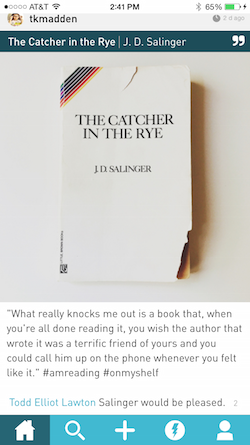
I’m not especially persuaded by Litsy on a personal level, much for the same reason I never liked the trend of throwing silent reading parties: it adds a weirdly performative element to the solitary pursuit of reading that never appealed to me. It’s impossible to attend a silent reading party without judging what other people read and, in return, worrying about what people think of the book that you brought along. Judging other people’s reading is a perfectly enjoyable pastime, by the way, and there’s no shame in it; I judge bookshelves at parties and read spines on the bus. But when everybody is seeing what you read and everybody is aware of being seen while reading, it adds an uncomfortable meta-level to the experience that makes me uncomfortable.
That said, there’s nothing wrong with Litsy, or with silent reading parties. Everybody makes their reading life public in one way or another; I co-own a website that publishes the opinions of people who read books, for crying out loud, so obviously I don’t think there’s any shame in that. If Litsy appeals to you, you should join up and use it. And if you join Litsy, you should friend me, too; maybe the joyousness of your sharing will inspire me to rethink how I approach the site.
But I do have some problems with the scale and scope of Litsy. I hate that you can only review books in one of four ways: Pick, So-So, Pan, or Bailed. It’s so simple it’s stupid. And all of the ways to react to the book — I’m not quite sure how “Blurb” is different from “Review,” to be honest — only allow you to use 250 characters at the most. To me, this seems like the biggest problem with Litsy: its refusal to allow lovers of words to respond to long collections of words with their own words. Granted, not every book review needs to be five thousand words long, but presumably most reading experiences are a little more substantial than just over two tweets’ worth of writing.
Again, I know I’m biased toward wordy responses to books. And I know that the internet is becoming an image-based communication medium. I just don’t know if I’m ready for the first post-literate literary social network, a place where you can fetishize the book as an object in a series of photos but you can’t discuss what moved you about the book unless your experience is roughly 125 words or less.
The world is littered with failed attempts at social networks — most recently Ello and Peach — because it’s hard to convince people to migrate to a new online home once they’re already invested in one. And Goodreads has a hell of a head start on Litsy. But it’s possible that Amazon’s involvement might be enough to convince the booksellers and librarians of Goodreads to pack up and move to higher (moral) ground. Of course, there’s nothing to stop Amazon from buying Litsy once that happens, too. In more ways than one, no online community is safe.
Your Week in Readings: The best events from Feb 29th - March 6th
MONDAY Your week starts at Town Hall with science journalist Sonia Shah. Her new book Pandemic examines the possibility of infectious disease destroying human civilization by examining the many times cholera has broken out over the last two centuries. Cholera has killed hundreds of millions of human beings. Which, you know, is depressing. But important!
TUESDAY We’re starting this day off by pointing out that Timothy Egan debuts his new book, Meagher, From Irish Immigrant to Hero, at Town Hall. Egan is one of Seattle’s heavyweights, and this is sure to be a huge reading. But we also like the smaller events, and Hugo House’s second Ask the Oracle reading at the Sorrento Hotel sounds like a very fun time. Three authors read works in response to audience questions, and the whole event is disguised as a fortune-telling experience. Today’s readers are New York poet Roberto Ascalon, Seattle novelist Megan Kruse (author of the excellent Call Me Home), and Seattle poet Imani Sims. Honestly, you could go to either of these events and have a lot of fun.
WEDNESDAY Up in Third Place Books Lake Forest Park Kathryn Aalto reads from her book The Natural World of Winnie-the-Pooh, which examines the story behind A.A. Milne’s childrens’ books through drawings, photographs, and biographical details. If you’re into behind-the-scenes material, you’ll love this one.
THURSDAY Elliott Bay Book Company hosts Sri Lankan author Nayomi Munaweera, whose new novel What Lies Between Us explores “the bonds between women, the lifelong impact of trauma, and feminism's last taboo.”
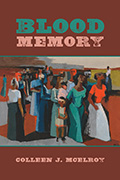
SATURDAY The third Rainier Valley Lit Crawl happens tonight, rain or shine. Tonight’s Crawl runs from Spinnaker Bay Brewing to Big Chickie to The Collaboratory to Union Bar, and it features writers including Paul E. LaPier, Kathryn Burgomaster, EJ Koh, Philip Randolph, Faiza Sultan, Becca HallJed Myers, and Mary Crane. I bet you’ve never attended a poetry reading in a Peruvian-style chicken restaurant, have you? Tonight’s your big chance. It’s free. What do yo uhave to lose?
SUNDAY As with most of our weeks recently, our week ends tonight at The Monorail Reading Series at Fred Wildlife Refuge. Tonight’s poets are all reportedly pioneers in one way or another, including new-to-Seattle poet Michael Harper, Portland author and Octopus Books assistant editor Hajara Quinn, and Copper Canyon poet Natalie Shapero. Pioneering or not, this seems like a stellar lineup of local and visiting poets. Plus: booze! What’s not to love?
The Sunday Post for February 28, 2016
The New Web Typography
Surely, you can picture them: the Penguin books with the colored covers, the little medalian at the bottom with the line-drawing of the bird logo? That design and layout are the work of the great typographer and designer Jan Tschichold. His most famous book, The New Typography, was a firebrand call from a young designer — one who later came to disown some of the more radical ideas he earlier held (I wrote about Tschichold, and how he got in trouble with the Nazis, and his relationship with Penguin in this essay).
This essay by Robin Rendle — intended for web designers, but which only gets into nitty towards the end — is a call for typography to be of its moment. Its moment, right now, is the web.
What’s wrong with a book made in the time of the early 19th century author and statesman Johann Wolfgang von Goethe, you might ask? Personally, I wouldn’t argue with all that much since these books were often quite the spectacle. According to Tschichold, however, books designed in the 19th century were for the people and the technology of the time; they solved problems that were entirely inapplicable to the needs of his own century a hundred years later.
MFA vs. CIA
What a choice: join the CIA, or attend the Iowa Writers' Workshop? Jennifer duBois recounts her choice.
When I was twenty-three, I was hired by the CIA. I was working at a Catholic school at the time, coaching squash and teaching seventh-grade social studies—which was funny, since I had never before seen a squash game before and was not even so much as a lapsed Catholic. I lived behind the school in a former convent where the only consistently functioning lights were a pair of glowing red exit signs. My prevailing feeling that year was one of intense personal absurdity, and it was in this spirit that I applied to the CIA (I liked international relations, and who knew they had an online application?) and the Iowa Writers’ Workshop (I liked writing stories, and what the hell?). These things certainly didn’t make any less sense than coaching squash and living in a convent—though they weren’t really ambitions as much as gestures: reflections of my general hope that I would, someday, do something else. Each was something in between a dice roll and a delusion, a promissory note and a private joke to no one but myself.
What Should We Say About David Bowie and Lori Maddox?
Lori Maddox wrote about having sex with David Bowie when she was 15, but has wrote glowingly about the experience. Jia Tolentino looks at how we should treat our icons in the light of the modern day, given the light of the murky water they swam in, then.
There are no precise enough words or satisfying enough conclusions to fully account for her story, or any like it. It’s easy to see what Bowie represents here: a sexual norm that has always appallingly favored men, and the abuse that stems from and surpasses even that. It is easy to denounce the part Bowie played in this, even with any number of purportedly mitigating factors: the political context, Maddox’s story, the fact that he lived with generosity and openness, the less generous fact that his synapses were perpetually blitzed with cocaine. It is less easy to turn over what Maddox evinces in this narrative, from the late 1970s to her account of it now—which is that women have developed the vastly unfair, nonetheless remarkable, and still essential ability to find pleasure and freedom in a system that oppresses them.
